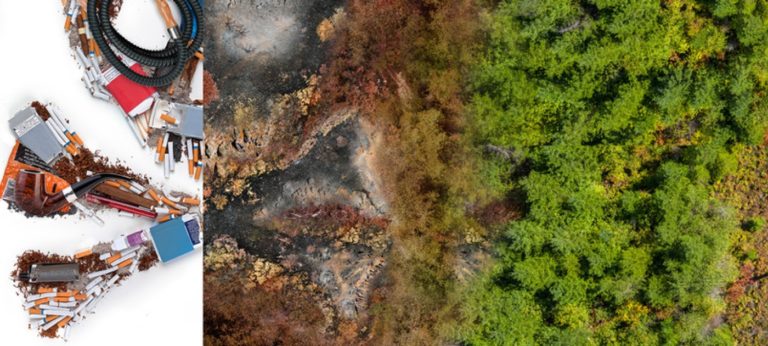World No Tobacco Day is observed on 31 May every year. This day is celebrated as a moment to raise public awareness of the bad effects of smoking.
This year, the theme of the commemoration is highlighting the impact of the tobacco industry on the environment.
The World Health Organization (WHO) on its official website, in commemoration of World No Tobacco Day 2022 which falls on Tuesday (May 31), states, every year, the negative impact of tobacco is very broad and adds to the unnecessary pressure on Earth’s resources that have been already exhausted rare and fragile ecosystems.
Through this warning, WHO invites the public to stop smoking in order to save the planet Earth. “Every cigarette smoked or tobacco product used throws away the harmful resources on which we depend,” the WHO wrote.
Also Read: The Forty-Four-Days of Glory: Azerbaijan’s Struggle for Justice and Peace
“Quitting smoking is for your health and the health of our planet. Tobacco smoke contributes to higher levels of air pollution,” the WHO added.
World No Tobacco Day was initiated by WHO in 1987. This day is deliberately observed to draw global attention to the tobacco epidemic and deaths from smoking-related diseases.
It is noted that the habit of smoking or using tobacco products has claimed 8 million lives every year. As many as 1.2 million of them occurred in the non-smokers group who were exposed to cigarette smoke.
In addition, the use of tobacco for cigarettes has damaged the environment, which in turn endangers human health, through cultivation, production, distribution, consumption, and post-consumption waste.
Also Read: Palestine Solidarity Month: A Collective Movement for Al-Aqsa and Palestine’s Freedom
Smoking is a major risk factor for Non-Communicable Diseases (NCD). Cancer, heart and blood vessel disease, and chronic obstructive pulmonary disease are closely related to smoking behavior (Tobacco Atlas, 2020).
Meanwhile, smoking in Indonesia kills at least 235,000 people every year.
The Research and Development Agency, Ministry of Health stated that losses due to productive people who become unproductive due to illness due to smoking reached around 4,180.27 trillion, while economic losses due to tobacco reached 375 trillion or one-fifth of Indonesia’s total state budget.
Then catastrophic disease, one of the main risk factors is smoking, which burdens more than 20 persen of all BPJS Health financing.
Also Read: Hassan al-Turabi: A Controversial Thinker from Sudan
The problem of conventional cigarettes has not been resolved yet, now a new product has emerged, namely electronic cigarettes with the same targets, children and adolescents.
This product has become increasingly public in a short time, as evidenced by the sharp increase in the prevalence of electronic smokers aged 10-18 years by 1.2% (Sirkesnas, 2016) to 10.9% (Riskesdas, 2018).
Data on electronic smokers also reached 11.5% in adolescents aged 13-15 years (GYTS, 2019).
This certainly threatens the demographic bonus that should have started to occur and be enjoyed by this nation.
Also Read: Who Exactly is the RSF Group Shaking Sudan?
There are four points that the WHO pays attention to on this year’s World No Tobacco Day.
1. Tobacco Damages the Environment
The cultivation, manufacture and use of tobacco poisons water, soil, beaches and city streets with chemicals, toxic waste, cigarette butts, including microplastics, and e-cigarette waste.
Don’t be fooled by the tobacco industry’s efforts to try and divert its attention from environmental harm by washing their products environmentally friendly through donations to sustainability initiatives and reporting on environmental “standards” that they often set themselves.
Also Read: The Two-State Solution (Palestine–Israel) in Historical Perspective
2. Get the Tobacco Industry To Fix Itself
The tobacco industry makes a profit by destroying the environment and must be responsible for environmental damage and is required to pay for waste and damage, including to recover the costs of collecting this waste.
3. Quit Smoking to Save the Earth
Every cigarette smoked or tobacco product used wastes a valuable resource on which human existence depends.
Also Read: Enchanted by K-Dramas, Dragged into Slander: Time for Muslims to Rise!
Quitting smoking will have a good impact on the health and well-being of the Earth. Tobacco smoke contributes to higher levels of air pollution and contains three types of greenhouse gases.
4. Help Tobacco Farmers Switch to Sustainable Crops
Governments and policy makers should support tobacco farmers to switch to alternative, more sustainable livelihoods.
This is to reduce the environmental impact of growing, preserving and manufacturing tobacco while continuing to implement tobacco control measures.
Also Read: Creating Opportunity and Avoiding Misery; Lesson Learn on Waste Recycling Issue
Negative Impacts of Tobacco
The following is the negative impact of tobacco as an ingredient for making cigarettes according to WHO.
1. Forest Clearing
An estimated 1.5 billion hectares of forest (mainly tropical) have been lost worldwide since the 1970s to tobacco, contributing up to 20% of the annual increase in greenhouse gases.
Also Read: Between the Treaty of Hudaybiyyah and Ceasefire in Gaza
Trees are cut down to clear land for tobacco farming, and wood is burned to treat tobacco leaves after harvest.
It takes about one whole tree to make 300 cigarettes.
About 200,000 hectares of land are cleared annually to grow and grow tobacco. As many as 600 million trees have been cut down to make cigarettes.
2. Causes Soil Depletion
Also Read: Peace Cannot Be Achieved Without a Palestinian State
Fertile soil that can be used to grow nutritious crops is used for tobacco. Soil depletion caused by tobacco growth is increasingly contributing to food insecurity and nutritional challenges.
Rehabilitating soil after tobacco farming is expensive.
Meanwhile, around 3.5 million hectares of land are destroyed to grow tobacco every year. Growing tobacco contributes to deforestation, especially in developing countries.
Deforestation for tobacco plantations promotes soil degradation and “yield failure” or the capacity of land to support the growth of crops or other vegetation.
Also Read: Facing the Wall: Netanyahu and Ambitions Built on Blood
3. Affects Water Supply
The entire life cycle of a cigarette requires about 3.7 liters of water, this includes cultivation, manufacture, distribution, use and disposal.
The average smoker can save up to 74 liters of water per day if they quit smoking.
The tobacco growing stage alone requires the same amount of water as a person needs for an entire year.
It is now known that cigarette filters (cigarette butts) are the most polluting and toxic substances found in water bodies.
It takes cigarette butts about 10 years to decompose, giving the nicotine and chemicals time to seep into the surrounding ecosystem.
A study from the EPA concluded that when cigarette butts are immersed in fresh water for 96 hours, approximately half the fish die.
Meanwhile, 22 billion tons of water are used to make cigarettes.
4. Polluting the Air
To produce one cigarette, 14 grams of CO2 are emitted throughout its life cycle.
Tobacco production accounts for nearly 84 million metric tons of CO2 equivalent emissions each year. That’s the equivalent of 280,000 rockets launched into space.
Tobacco smoke contributes to higher levels of air pollution and contains three types of greenhouse gases.
The content is carbon dioxide, methane, and nitrous oxide, which pollute the indoor and outdoor environment.
5. Damage the Environment
Globally, the estimated weight of waste generated annually from the entire tobacco life cycle is approximately 25 million metric tons.
Most commercial cigarettes have a cellulose acetate filter installed; These additives do not degrade well and are a source of microplastic contamination of the environment.
Approximately 4.5 trillion cigarettes are dumped into the environment every year.
The littering behavior survey found that around 65% of smokers dispose of cigarette butts improperly (e.g. on sidewalks, beaches, etc.)
There are more than 7,000 chemicals released into the environment from the use of a single cigarette – 70 of which are known carcinogens.(T/RE1)
Mi’raj News Agency (MINA)
































 Mina Indonesia
Mina Indonesia Mina Arabic
Mina Arabic